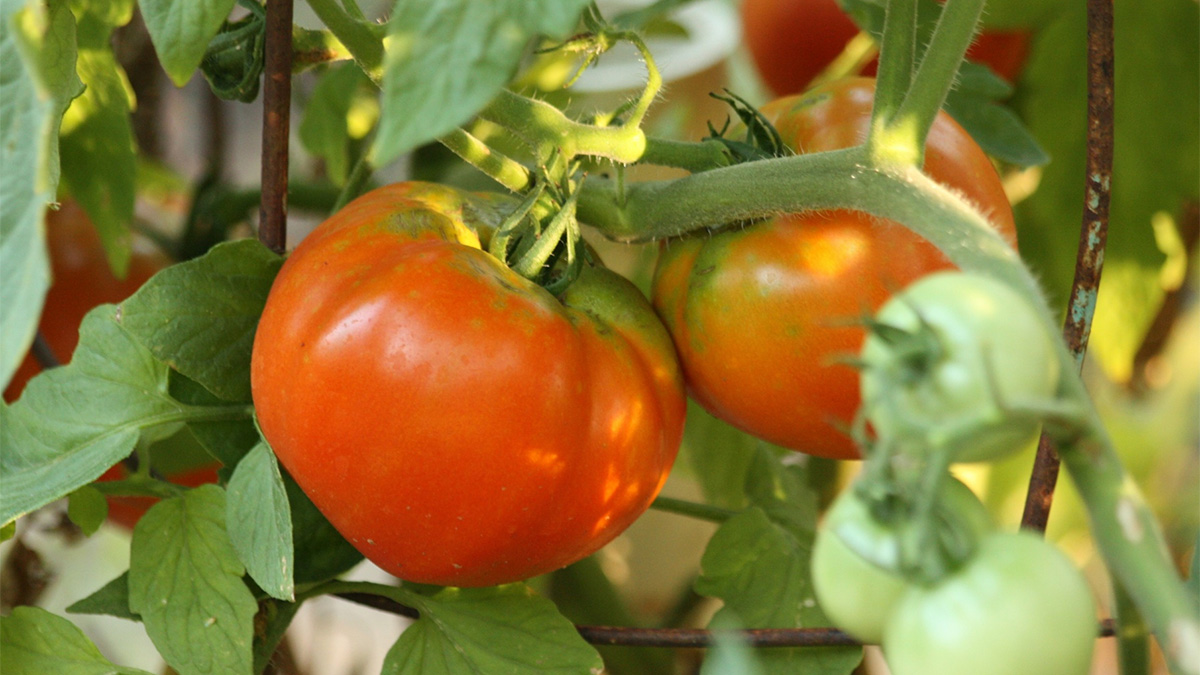Tomato Growing Tips for a Bigger and Better Harvest

Tomatoes are one of the most rewarding crops to grow, but they can also be one of the trickiest. From choosing the right varieties to mastering soil, water, and pruning techniques, getting it right takes a little know how. Whether you’re a first-time grower or looking to improve this season’s harvest, these practical tips will help you grow bigger, better, and more flavorful tomatoes all summer long.
Choosing the right tomato varieties
Not all tomatoes are created equal. If you want to maximize your harvest, choosing the right variety for your space, climate, and goals is essential.
Determinate tomatoes grow to a set height and produce most of their fruit over a few weeks. These are great for small gardens, raised beds, or container growers who want a single, focused harvest. Indeterminate tomatoes continue to grow and produce fruit until frost, making them a better option for those who prefer ongoing harvests throughout the season.
Think about what you want most: high yield, rich flavor, disease resistance? Heirlooms like ‘Brandywine’ or ‘Black Krim’ are known for taste, while hybrids like ‘Celebrity’ or ‘Early Girl’ are bred for productivity and resilience. Matching the variety to your environment and needs sets the stage for success.
Starting strong: seeds vs. seedlings
Starting from seed gives you access to dozens of unique tomato varieties you won’t find in stores. It’s also satisfying to watch your plants grow from day one. That said, it does require some planning. You’ll need grow lights, seed trays, and a warm, indoor space to get started about 6–8 weeks before your last frost date.
Prefer to skip that step? Buying seedlings from a local nursery works just as well. Choose healthy plants with sturdy stems and vibrant green leaves. Avoid leggy or yellowing plants as they often struggle to establish after transplanting.
Whether you grow from seed or buy starts, a healthy, well-rooted young plant is the best foundation for a productive season.
Soil preparation and nutrients
Tomatoes are heavy feeders, and they love rich, well-draining soil. Ideally, you’re working with loamy soil rich in organic matter, with a pH between 6.0 and 6.8. Before planting, add compost or well-rotted manure to improve texture and fertility.
Tomatoes also need calcium to avoid blossom end rot, so consider working in some crushed eggshells or lime. Don’t forget phosphorus and potassium, especially during flowering and fruiting stages. While nitrogen is important early on, too much can lead to lush foliage and very few tomatoes.
Healthy soil equals healthy plants. Investing in soil prep before planting always pays off later in the season.
Planting techniques that promote growth
When planting tomatoes, deeper is better. Strip the lower leaves and bury the stem up to the first or second set of leaves. This encourages the plant to develop roots all along the buried stem, resulting in a stronger root system.
Give each plant enough space to breathe. Crowding leads to poor airflow, which encourages disease. Space indeterminate varieties about 24 to 36 inches apart, and determinate ones slightly closer.
A sturdy plant with room to grow will reward you with more fruit and fewer problems later.
Watering strategies for healthy plants
Tomatoes don’t like wet feet or bone-dry roots. The key is consistency. Deep watering two to three times a week is usually enough, depending on your climate and soil type.
Try to water in the morning so the leaves dry by evening. This helps prevent fungal diseases. Drip irrigation or a soaker hose makes watering more efficient and keeps water off the foliage.
Mulching around the base of your plants helps keep soil moisture even and reduces stress from heat. It also cuts down on weeds which is another bonus.
Inconsistent watering is one of the top reasons for issues like cracked fruit and blossom end rot, so make it a habit to check your soil regularly.
Pruning and training for maximum yield
Support your tomato plants early with cages, stakes, or trellises. This prevents sprawling, keeps fruit off the ground, and improves air circulation.
Indeterminate tomatoes especially benefit from pruning. Remove suckers from the small shoots between the main stem and leaf branches to help the plant focus energy on fruit production rather than excess foliage. This simple step can make a big difference in both the size and quality of your harvest.
Determinate varieties generally need less pruning, but removing any damaged or diseased leaves still helps maintain plant health.
Feeding your tomatoes throughout the season
Tomatoes don’t just want food they need it. After the initial boost from compost and soil amendments, continue feeding your plants every two to three weeks during the growing season.
Look for a fertilizer higher in phosphorus and potassium to promote flowering and fruiting. Avoid overloading with nitrogen, which encourages leaf growth but can delay or reduce fruit development.
Organic options like compost tea or fish emulsion work well and are gentler on the soil. They also feed beneficial microbes, creating a healthier environment for roots.
Pay attention to how your plants look. Pale leaves or sluggish growth are signs they may need more nutrients.
Common tomato problems and how to avoid them
Tomatoes can be magnets for trouble but with a little care, you can avoid most issues. Check your plants often for pests like aphids, whiteflies, or tomato hornworms. Hand-picking, spraying with insecticidal soap, or using neem oil are all effective, low-impact options.
Diseases like early blight or powdery mildew tend to strike when airflow is poor or leaves stay wet for too long. Space your plants, water at the base, and remove any lower leaves that touch the soil.
Rotate your crops each year to avoid soil-borne pathogens. If possible, don’t plant tomatoes in the same spot more than once every three years.
A clean, well-ventilated garden is your best defense.
Harvesting tips for better flavor and longer storage
Tomatoes are ready to pick when they’ve fully colored and feel just slightly firm to the touch. Ripe fruit will come off the vine easily with a gentle twist or snip.
For best flavor, harvest in the morning once the dew has dried. If you need to pick early due to weather, pests, or the threat of cracking then let the tomatoes ripen indoors on a windowsill or in a paper bag.
Avoid storing ripe tomatoes in the fridge unless absolutely necessary. Cold temperatures dull flavor and texture. Instead, keep them at room temperature and enjoy them within a few days for the best taste.
Bonus tips for extending the season
Want more tomatoes? You can stretch your growing season with a few simple strategies. Start by covering your plants with row covers or frost cloths during cold snaps. These provide protection and trap warmth, especially useful in early spring or late fall.
Stagger your planting dates so you have tomatoes maturing at different times. This prevents a single harvest overload and extends your enjoyment well into the season.
In warmer climates, indeterminate tomatoes can even be overwintered in containers or greenhouses. With proper pruning and protection, they’ll keep producing far beyond the typical season.
Conclusion
Growing tomatoes doesn’t have to be a guessing game. With the right foundation, consistent care, and a few smart techniques, you can enjoy a harvest that’s both abundant and delicious. Pay attention to your soil, water wisely, prune with purpose, and keep an eye out for common issues. Over time, your tomato-growing confidence will grow right along with your plants.
